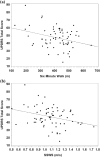The Unified Parkinson's Disease Rating Scale as a predictor of peak aerobic capacity and ambulatory function
- PMID: 23341319
- PMCID: PMC4545638
- DOI: 10.1682/jrrd.2011.06.0103
The Unified Parkinson's Disease Rating Scale as a predictor of peak aerobic capacity and ambulatory function
Abstract
The Unified Parkinson's Disease Rating Scale (UPDRS) is a widely applied index of disease severity. Our objective was to assess the utility of UPDRS for predicting peak aerobic capacity (VO2 peak) and ambulatory function. Participants (n = 70) underwent evaluation for UPDRS (Total and Motor ratings), VO2 peak, 6-minute walk distance (6MW), and 30-foot self-selected walking speed (SSWS). Using regression, we determined the extent to which the Total and Motor UPDRS scores predicted each functional capacity measure after adjusting for age and sex. We also tested whether adding the Hoehn and Yahr scale (H-Y) to the model changed predictive power of the UPDRS. Adjusted for age and sex, both the Total UPDRS and Motor UPDRS subscale failed to predict VO2 peak. The Total UPDRS did weakly predict 6MW and SSWS (both p < 0.05), but the Motor UPDRS subscale did not predict these ambulatory function tests. After adding H-Y to the model, Total UPDRS was no longer an independent predictor of 6MW but remained a predictor of SSWS. We conclude that Total and Motor UPDRS rating scales do not predict VO2 peak, but that a weak relationship exists between Total UPDRS and measures of ambulatory function.
Conflict of interest statement
Figures
Similar articles
-
The relationships between the unified Parkinson's disease rating scale and lower extremity functional performance in persons with early-stage Parkinson's disease.Neurorehabil Neural Repair. 2009 Sep;23(7):657-61. doi: 10.1177/1545968309332878. Epub 2009 Mar 31. Neurorehabil Neural Repair. 2009. PMID: 19336530
-
Metric attributes of the unified Parkinson's disease rating scale 3.0 battery: part II, construct and content validity.Mov Disord. 2006 Nov;21(11):1892-8. doi: 10.1002/mds.21071. Mov Disord. 2006. PMID: 16958134
-
Improved clinical status, quality of life, and walking capacity in Parkinson's disease after body weight-supported high-intensity locomotor training.Arch Phys Med Rehabil. 2013 Apr;94(4):687-92. doi: 10.1016/j.apmr.2012.11.025. Epub 2012 Nov 24. Arch Phys Med Rehabil. 2013. PMID: 23187043 Clinical Trial.
-
[Rating scale and functional prognosis of Parkinson's disease].Nihon Rinsho. 2000 Oct;58(10):2132-8. Nihon Rinsho. 2000. PMID: 11068460 Review. Japanese.
-
The Unified Parkinson's Disease Rating Scale (UPDRS): status and recommendations.Mov Disord. 2003 Jul;18(7):738-50. doi: 10.1002/mds.10473. Mov Disord. 2003. PMID: 12815652 Review.
Cited by
-
Influence of motor impairment on exercise capacity and quality of life in patients with Parkinson disease.J Exerc Rehabil. 2021 Aug 23;17(4):241-246. doi: 10.12965/jer.2142290.145. eCollection 2021 Aug. J Exerc Rehabil. 2021. PMID: 34527635 Free PMC article.
-
Exercise response in Parkinson's disease: insights from a cross-sectional comparison with sedentary controls and a per-protocol analysis of a randomised controlled trial.BMJ Open. 2017 Dec 26;7(12):e017194. doi: 10.1136/bmjopen-2017-017194. BMJ Open. 2017. PMID: 29282259 Free PMC article. Clinical Trial.
-
Feasibility and effect of high-intensity training on the progression of motor symptoms in adult individuals with Parkinson's disease: A systematic review and meta-analysis.PLoS One. 2023 Nov 10;18(11):e0293357. doi: 10.1371/journal.pone.0293357. eCollection 2023. PLoS One. 2023. PMID: 37948405 Free PMC article.
-
Development and Validation of Ambulosono: A Wearable Sensor for Bio-Feedback Rehabilitation Training.Sensors (Basel). 2019 Feb 8;19(3):686. doi: 10.3390/s19030686. Sensors (Basel). 2019. PMID: 30743986 Free PMC article.
-
Contribution of Axial Motor Impairment to Physical Inactivity in Parkinson Disease.Am J Phys Med Rehabil. 2016 May;95(5):348-54. doi: 10.1097/PHM.0000000000000384. Am J Phys Med Rehabil. 2016. PMID: 26368837 Free PMC article.
References
-
- Ebersbach G, Baas H, Csoti I, Müngersdorf M, Deuschl G. Scales in Parkinson’s disease. J Neurol. 2006;253(Suppl 4):IV32–35. http://dx.doi.org/10.1007/s00415-006-4008-0. - DOI - PubMed
-
- Poewe W. Clinical measures of progression in Parkinson’s disease. Mov Disord. 2009;24(S2):S671–76. - PubMed
-
- Tanji H, Gruber-Baldini AL, Anderson KE, Pretzer-Aboff I, Reich SG, Fishman PS, Weiner WJ, Shulman LM. A comparative study of physical performance measures in Parkinson’s disease. Mov Disord. 2008;23(13):1897–1905. http://dx.doi.org/10.1002/mds.22266. - DOI - PubMed
-
- Brusse KJ, Zimdars S, Zalewski KR, Steffen TM. Testing functional performance in people with Parkinson disease. Phys Ther. 2005;85(2):134–41. - PubMed
-
- Skidmore FM, Mackman CA, Pav B, Shulman LM, Garvan C, Macko RF, Heilman KM. Daily ambulatory activity levels in idiopathic Parkinson disease. J Rehabil Res Dev. 2008;45(9):1343–48. http://dx.doi.org/10.1682/JRRD.2008.01.0002. - DOI - PubMed
Publication types
MeSH terms
Grants and funding
LinkOut - more resources
Full Text Sources
Other Literature Sources
Medical

